Books
Books

tendentious | neo-semantics
Transcribed from previously unpublished text-sound transcripts, the edition also brings together selections from Greenham’s aphorisms and 50 words-stories and a fragmentary pre / post-script from documents in the Lily Greenham Archive, and is accompanied by an epistolary insert from sound poet Larry Wendt.
Greenham was an artist / composer / writer / performer and inventor of the term ‘lingual music’. This launch is part of a two-day symposium that coincides with the exhibition ‘Lily Greenham: An Art of Living’ at the Badischer Kunstverein, the first large-scale retrospective of her work.

Broken Villas
Written in response to three “physical” photographs, ‘Broken Villas’ contains and considers how a vessel might clasp tightly to known volumetric identities, but also loom with a set of accentuated clues towards otherness: the excavated seams in the earth and what we fill those holes with, imaginary or otherwise; the glacial erraticism of the boulder; the queer crimping of a hotel pillowcase; the modes via which objects are housed as display, but also packaged away, with sorrow, with fear, with erotism etc.

Working Through Objects
The text by Hiller navigates the boundaries between art, anthropology and psychoanalysis in relation to her installation at the Freud Museum in 1994 titled At the Freud Museum. Accompanying images included throughout from Book Works UK archive, the commissioner of the artwork and talks that this text is edited from.
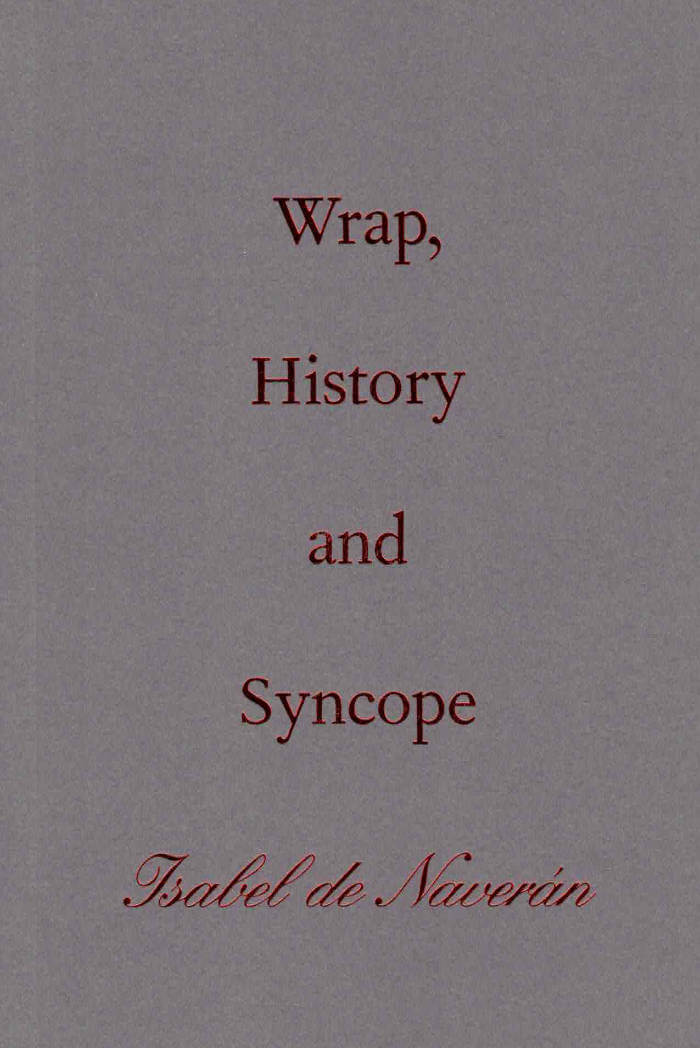
Wrap, History and Syncope
18 July 1936, Bayonne. After hearing the news of the Fascist uprising, the Spanish dancer and bailaora Antonia Mercé y Luque, known as La Argentina, suffers a syncope and dies in fateful synchrony with the Second Republic. History, and the artist’s body, have been seized and broken by the event.
In close dialogue with images and historical documents, Isabel de Naverán pursues the reverberations of that shock and how it resonates with collective pain and artistic translations (by Federico García Lorca, Gertrude Stein, Kazuo Ohno and others). How does history affect and move through bodies? How do living bodies carry and pass on cultural legacy and collective memory? What do these complex movements reveal about the present? Wrap, History and Syncope is an affective journey that invites the reader into tracing and revisiting other bodies, to ultimately dance their difference and multiplicity for oneself.
Isabel de Naverán is a writer and researcher. Concern with the passage and use of time is the backbone of her work, which focuses on bodily transmission and the examination of the concept of historical time by way of ephemeral and fugitive practices. She holds a PhD in art from the University of the Basque Country.
Translation from Spanish: Toni Crabb
Graphic design: Michaël Bussaer
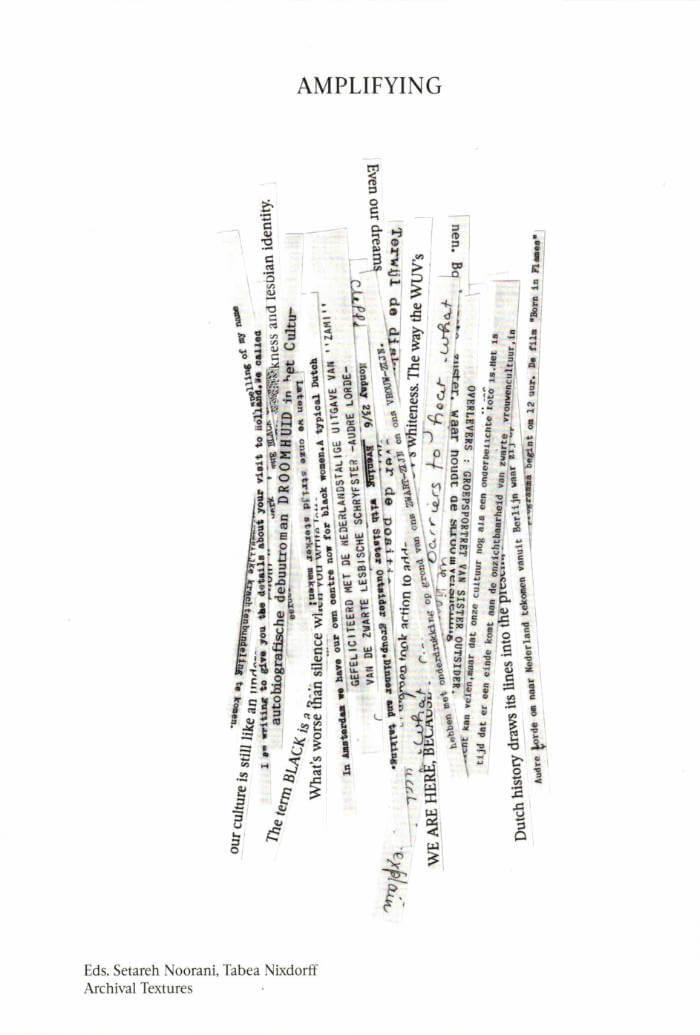
Archival Textures - Amplifying
Setareh Noorani, Tabea Nixdorff
The book Amplifying brings together written manifestations that trace the beginnings of Black feminism in the Netherlands. Amplifying means giving credit to, mentioning, over and over, and supporting the circulation of sources and authors that are formative for our thinking and practices. In the early 1980s, the political term “black” (zwart in Dutch) was introduced in the Netherlands to build alliances between women from different diasporic communities, who were faced with racism in their everyday lives.
Archival materials featured in this book include the original manuscript of the essay “Survivors: Portrait of the Group Sister Outsider” (1984), written by Gloria Wekker in collaboration with the Black lesbian literary group Sister Outsider, the seminal speech Statement of the Black Women’s Group (1983) by Julia da Lima, a contextualizing interview with Tineke E. Jansen and Mo Salomon (1984), excerpts from the book launch of Philomena Essed’s Everyday Racism (1984), and short texts authored by other Black feminist groups in the Netherlands, such as Zwarte Vrouwen & Racisme, Flamboyant, Ashanti, and Groep Zwarte Vrouwen Nijmegen.

Archival Textures - Posting
Carolina Valente Pinto, Tabea Nixdorff
The book Posting brings together a selection of feminist posters from Dutch archives to reflect on posting as an activist strategy, holding the potential to create counter-publics to mainstream culture and to fight against the erasure, exoticization, or tokenism of bodies and experiences that deviate from normative preconceptions.
As is the case for many professions, in the history of Dutch graphic design the absence of women, non-binary, queer, Black designers is striking. This doesn’t only point back to systematic processes of exclusion in the first place, but also to the biases at play regarding whose work is remembered and archived. While efforts have been made to add forgotten names to the existing canon, the many posters, flyers and other printed matter shelved in queer and feminist archives remind us to question the notion of single authorship altogether and instead study graphic design as a decisively collaborative and transdisciplinary practice, which is especially true for community-led and volunteer-based projects.
The posters featured in this book point to this rich landscape of feminist organizing, and were found at the International Institute of Social History and the International Archive for the Women’s Movement (IAV-Atria) in Amsterdam.
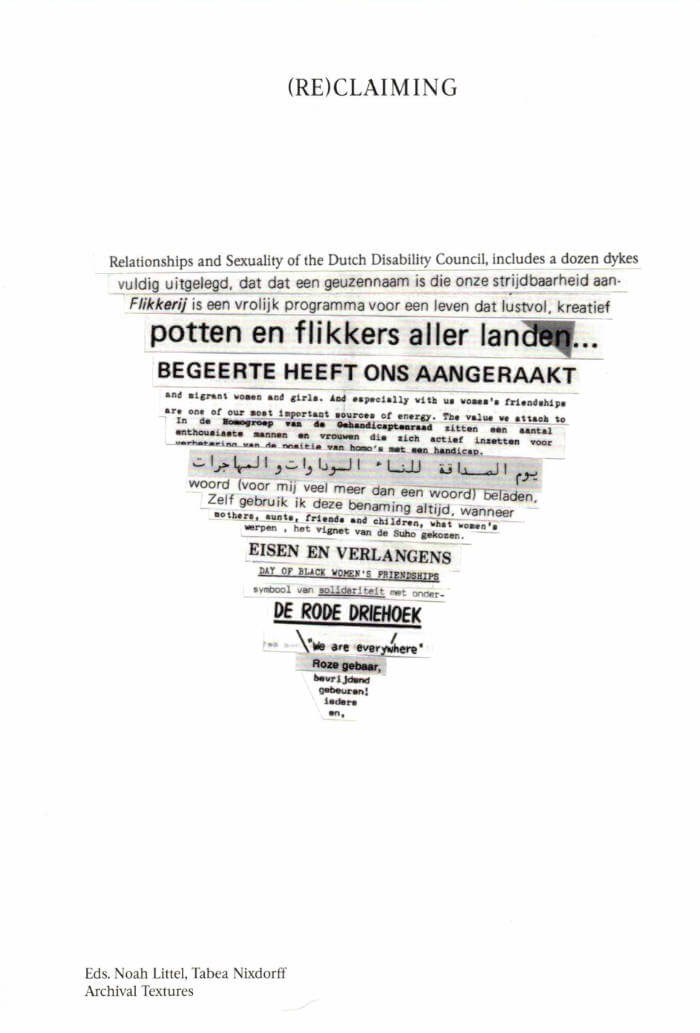
Archival Textures - (Re)claiming
The book (Re)claiming presents ways in which various queer and feminist communities and initiatives in the Netherlands have (re)claimed the triangle—along with other symbols, words and stories—and in doing so take up an empowering position in a hostile society.
Besides a collection of buttons, archival materials featured in this book include short statements and flyers by queer groups such as SUHO, Sjalhomo, Roze Front, Roze Driehoek, Roze Gebaar, Van Doofpot tot Mankepoot, Interpot/ILIS, Lesbisch Archief Amsterdam, Strange Fruit Vrouwen and Groep Zwarte Vrouwen Nijmegen, as well as a text by Karin Daan, the designer of the Homomonument in Amsterdam. With this selection, this book brings together queer, trans, crip, feminist, Jewish and Black perspectives on (re)claiming as an activist strategy.
Most of these materials were researched at IHLIA LGBTI Heritage in Amsterdam, with additions found at the International Institute of Social History and the International Archive for the Women’s Movement (IAV-Atria) in Amsterdam, and LAN Lesbisch Archief Nijmegen.

Christopher D’Arcangelo
Despite having been active for only four years before passing away at the young age of twenty-four, Christopher D’Arcangelo (1955–1979) is a key, though lesser-known, figure of 1970s Institutional Critique in New York City. Even generations later, D’Arcangelo’s singular approach remains wholly unique in its radicality and generosity. This first estate-approved monograph illuminates his momentous practice after many decades of limited access to the materials surrounding it.
The publication also includes new contributions from figures who have punctuated D’Arcangelo’s practice—such as Peter Nadin, Daniel Buren, Louise Lawler and Janelle Reiring—as well as photographic contributions by artist Heji Shin and a new text by Nicholas Martin.

First Drafts #2: Canonically Speaking
Canonically Speaking is the second title to appear on the First Drafts imprint, a zigzag in Kunstverein Publishing’s output that’s dedicated to publishing completed manuscripts that would otherwise, for an array of reasons, not see the light of day in this rough early form.
Central to Canonically Speaking is the idea that (female) life is an inherently surrealist experience. In this spirit, the ‘absurd’ is embraced as a means to speak out on themes such as self-image, spirituality, mental health and work. While slipping between poetry, comprehensive list-making, knock knock jokes and intertextual references, forms of recital and misinterpretation often take place, whereby characters quote and repeat sentences and words from a large variety of sources, jumping from the health benefits of whale blubber to court transcripts of Bill Clinton's impeachment to the plasma that is released when microwaving two grapes side by side.

The Wastes
After the death of her mother a woman decides to visit a familiar strip of rural upland, darkly identified on the South Pennines Ordnance Survey map as: The Waste. As she moves between trains, shunted by public encounters and haunted by past bar jobs, damp bedsits and a press shot of Vanessa Redgrave smoking in the bath, found slipped between the pages of her mother’s diary, the threshold between her past, present and future self dissolves. Fringe images she has neither designed nor authored begin to steer her toward grid reference 3499, where underfoot the semi-solid mud turns with worms and ants.
The Wastes is published as part of Arrhythmia, a series curated for Book Works by Katrina Palmer.
Roy Claire Potter works between performance and experimental art writing with recent work commissioned by Tate Britain and Tate Publishing, Reduced Listening for BBC Radio 3, Cafe OTO and Counterflows, and Primary. They are Senior Lecturer in Fine Art at Liverpool John Moores University.
Katrina Palmer is an artist and writer, living in London. She is the author of The Dark Object (2010), The Fabricators Tale (2014), End Matter (2015) and Black Slit (2023), all published by Book Works. She has exhibited extensively, including with an Artangel Open commission (2015), at Henry Moore Institute (2015-16), Yorkshire Sculpture Park (2018), and with Estuary and Waterfronts (2021). She received the Paul Hamlyn Foundation Award for Artists (2014).
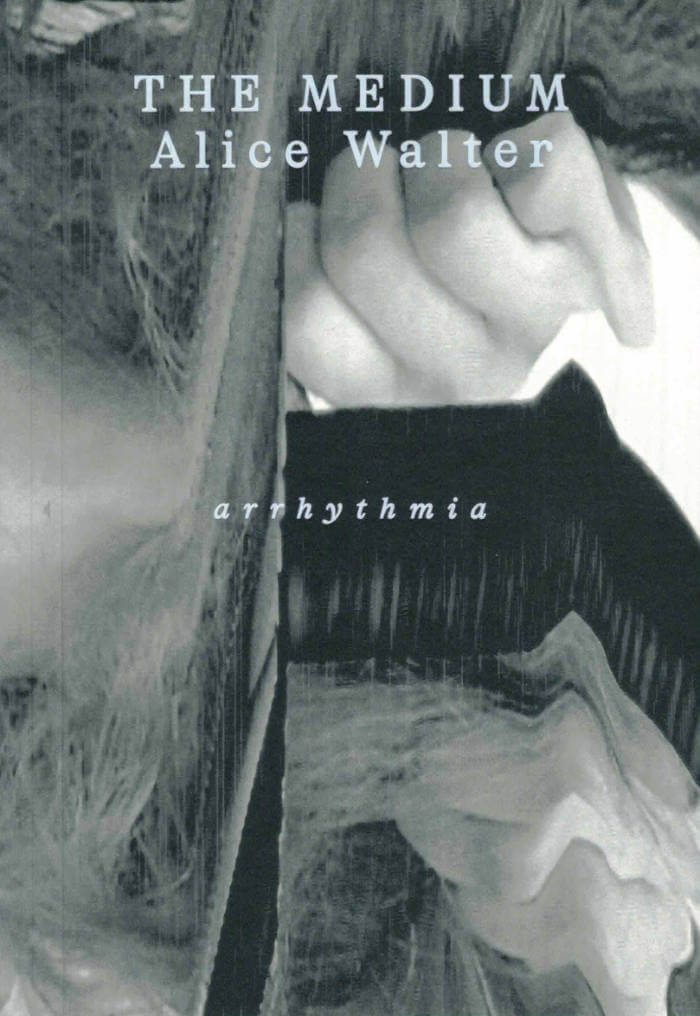
The Medium
To read The Medium is to be submerged in a stream of consciousness populated by uninvited voices from the underworld. Animated, urgent, and brutally propulsive, this cacophony of competing narratives begins to upset the boundary between the living and the dead. The Medium is an alchemical novel, shimmering with insight from the depths of a black lake.
The Medium is published as part of Arrhythmia, a series curated for Book Works by Katrina Palmer.
Alice Walter is an artist, writer and medium – living and working in the UK. She has a BA in Fine Art, Film and Video from Central Saint Martins, UAL and a MFA from The Ruskin School of Art, Oxford University. Her practice combines collage, psychosexual sculpture, VHS and shamanism. Through these disciplines, Alice creates surreal and sensory spaces that open channels for the unseen.
Katrina Palmer is an artist and writer, living in London. She is the author of The Dark Object (2010), The Fabricators Tale (2014), End Matter (2015) and Black Slit (2023), all published by Book Works. She has exhibited extensively, including with an Artangel Open commission (2015), at Henry Moore Institute (2015-16), Yorkshire Sculpture Park (2018), and with Estuary and Waterfronts (2021). She received the Paul Hamlyn Foundation Award for Artists (2014).

Saborami: Expanded facsimile edition
Cecilia Vicuña created Saborami in the aftermath of the September 1973 military coup in Chile. Combining poetry, journal entries, documentation of artworks including assemblages and paintings, the book was published in Devon, England in an edition of 250 hand-made copies by the artist-led Beau Geste Press. It was one of the first artistic responses to the violence of the fascist junta.
In recent years, Vicuña has gained increasing renown, including a retrospective at Kunstinstituut Melly (FKA Witte de With, 2019) and installations at the Guggenheim (2022); and Tate Modern (2023). Saborami is one of her most important works, made at a turning point in her life and career, and reverberating through to the present day. Though the book is highly regarded, it has also been hard to access. This new, expanded facsimile edition remedies this oversight, and restates Saborami as a central example of artistic engagement in material and revolutionary resistance.
Engaging obliquely with the legacies of surrealism, contemporaneous experiments in concrete poetry and the British conceptual art practices of the 1960s and 1970s, Saborami is part of an exilic and internationalist tradition. Years ahead of her time, Vicuña outlines an eco-socialist and feminist vision in the face of defeat.
Coinciding with the fiftieth anniversary of the book’s original publication and of the coup in Chile, this expanded edition contains a new introduction by art historian and curator Amy Tobin and poet and writer Luke Roberts. It includes rarely seen archival material from Vicuña’s time in London, such as contributions to the feminist newspaper Spare Rib, commentary from BBC coverage, and her role in Artists for Democracy in Chile and other solidarity campaigns.
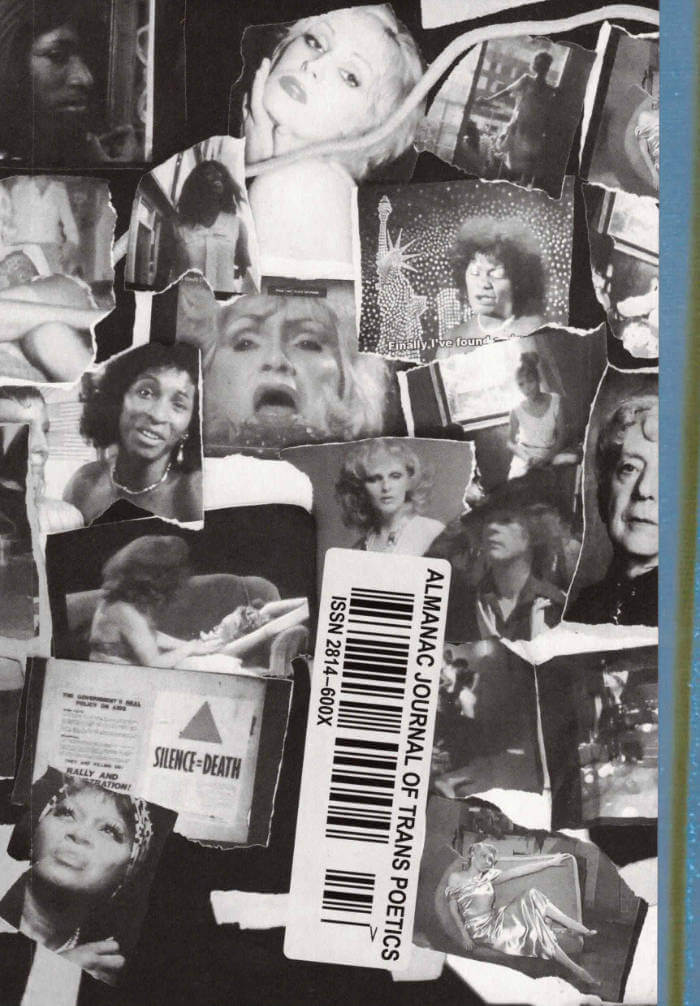
Almanac Journal of Trans Poetics: ISSUE #3 Cinema
In this issue, you’ll find different angles and takes on trans cinema. Featuring 22 contributors — the issue got pieces on gothic cinema, growing up as a TV kid in the 90s, trans femme film favs, cripness in Cronenberg’s work, love letters to the intimacy of the cinema hall and much more!
Sit back and get comfortable and let this third release take you on a journey through interviews, essays, comics, YouTube playlists, top favourite movie lists and beautiful, powerful film stills. This one is not to be missed!

A Book Knot Book
A Book Knot Book is a 208 pages long performance, the first from the research and publishing initiative Body Text. In this study of language in action systems of meaning-making crash, sparkle and swoon. In a playful voice over A Book Knot Book self-reflects on the materialities and choreographies of publishing, reading and writing. With guest stars in fragments; Monique Wittig, Yvonne Rainer, Cristina Rivera Garza, Amiri Baraka, Will Rawls, David Abram, Thich Nhat Hanh and more.
Edited and designed by Sara Kaaman. Published with the support of Stockholm University of the Arts.

Confidences / Oracle
Oracles don’t require belief—they now theatrically suspend disbelief. No longer advisors of world policy, they run Locus Solus, a town that has come to ramble around an eponymous theatre and chocolate factories. Theo, a centuries-old vampire intent on remaining contemporary through performance, visits Locus Solus, which is hosting Praise Estate, an international theatre festival. He uses the festival as an opportunity to stay with Gean, his oracle boyfriend, who is there visiting family. Theo has a fetish for the future, fixated on the one thing he is in no shortage of.
Confidences / Oracle is a lover’s trip to a weeklong theatre festival. A vehicle for recontextualising recent performance scripts and texts, Oracle is the third instalment in Ivan Cheng’s Confidences series, which intertwines vampires and performance as sites for circulation and recognition.
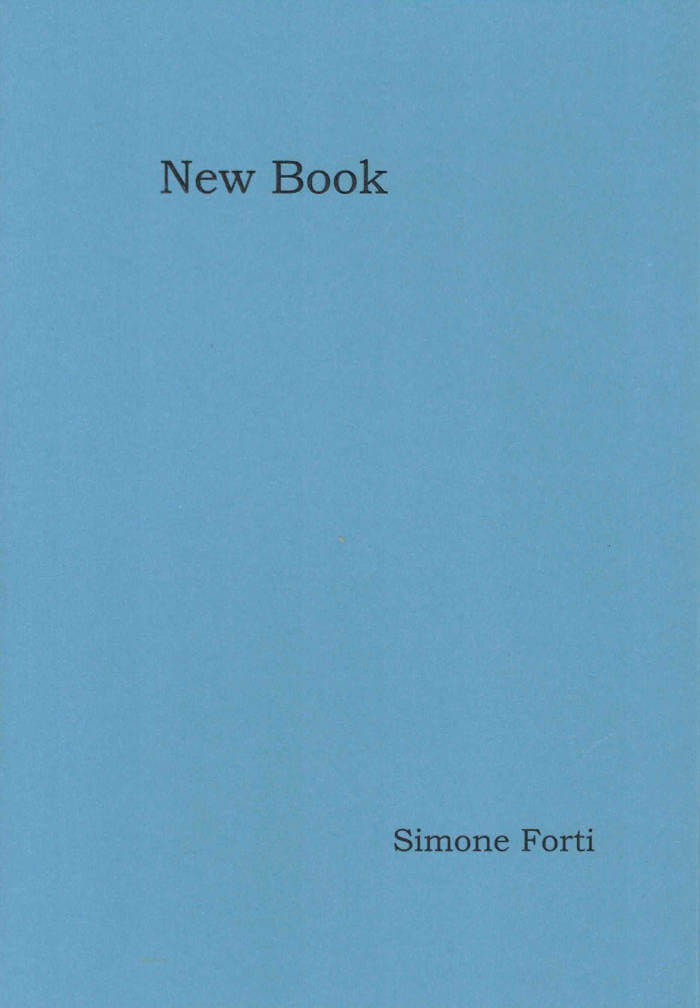
New Book
A new poem composed by the legendary dancer, artist and choreographer Simone Forti.
New Book is the title of a new poem composed of three existing poems re-edited by Simone Forti. As reading this poem, one moves forward with wonder amid everyday memories, recollections of life, a sense of civic duty, glimpses of a precarious world, the beauty of nature, melancholy, a rage to live.
American dancer and choreographer Simone Forti (born 1935 in Florence, Italy) has been a leading figure in the development of contemporary performance over more than fifty years. Artist, choreographer, dancer, writer, Forti has dedicated herself to the research of a kinesthetic awareness, always engaging with experimentation and improvisation. Investigating the relationship between object and body, through animal studies, news animations and land portraits, she reconfigured the concept of performance and dance. Forti emigrated from Italy with her family via Switzerland to Los Angeles in 1938, where she subsequently studied for four years with choreographer Anna Halprin and has since spent most of her life. She joined the experimental downtown art scene in New York during the emergence of performance art, process-based work and Minimal Art and spent a fruitful time in Rome in the late 1960s, where she used the spaces of L'Attico to study and perform. Her work is seen as a precursor of the famous Judson Dance Theater—a group of artists experimenting with dance, including Trisha Brown, Steve Paxton, and Yvonne Rainer—and Minimal Art, although she prefers to be referred simply as a "movement artist."

What Can Theatre Do
Miguel A. Melgares, Silvia Bottiroli
What Can Theatre Do invites artists and thinkers to explore the potential of the performing arts, the political role of theatre and its ability to imagine alternative realities and future scenarios, ranging from essays to artistic interventions.
At a time when the relation between art and society is under permanent scrutiny, the utterance What can theatre do serves as an open invitation for artists and thinkers alike to reimagine the potential agency of the performing arts. The formulation of this sentence is both ambitious and ambiguous since the affirmative or interrogatory status remains undefined. The intonation of the sentence can provide both a sense of hope and belonging or a nihilist sensation of powerlessness. It could provide a resource for research development and analytic inquiries, but could also serve as a suggestion to trigger political action.
From fictional interviews to recipes, social-media exchanges to dramaturgical texts, theoretical essays to artistic interventions, the contributions gathered here are a diverse and multifaceted collection of dialogues. These interventions are singular and unique but share concerns and desires about the politicality of theatre as a realm where possible alternative realities can be enacted and potential future scenarios can be collectively rehearsed.
What Can Theatre Do tries to explore the idea of a book as a complex performative apparatus that can generate a space within which art and theory, and therefore also strategies of reality-making and of fiction-making, can entangle and affect one another, creating possibilities for the emergence of the not yet imagined.
Contributions by Lotte van den Berg, Carolina Bianchi, Silvia Bottiroli, Ilenia Caleo, Laura Cull Ó Maoilearca, Piersandra Di Matteo, Valeria Graziano, Ainhoa Hernández Escudero, Samara Hersch, Asa Horvitz, Mala Kline, Low Kee Hong, Tom Oliver Jacobson, Miguel A. Melgares, Juan Miranda, Ogutu Muraya, Mazlum Nergiz, Andrej Nosov, nyamnyam (Ariadna Rodríguez and Iñaki Alvarez), Giulia Palladini, Venuri Perera, Livia Andrea Piazza, Amanda Piña, Annalisa Sacchi, Mariana Senne, Agat Sharma, Lara Staal, Elioa Steffen, Rolando Vázquez, Elioa Steffen, Suvani Suri, Pankaj Tiwari, Ingrid Vranken.
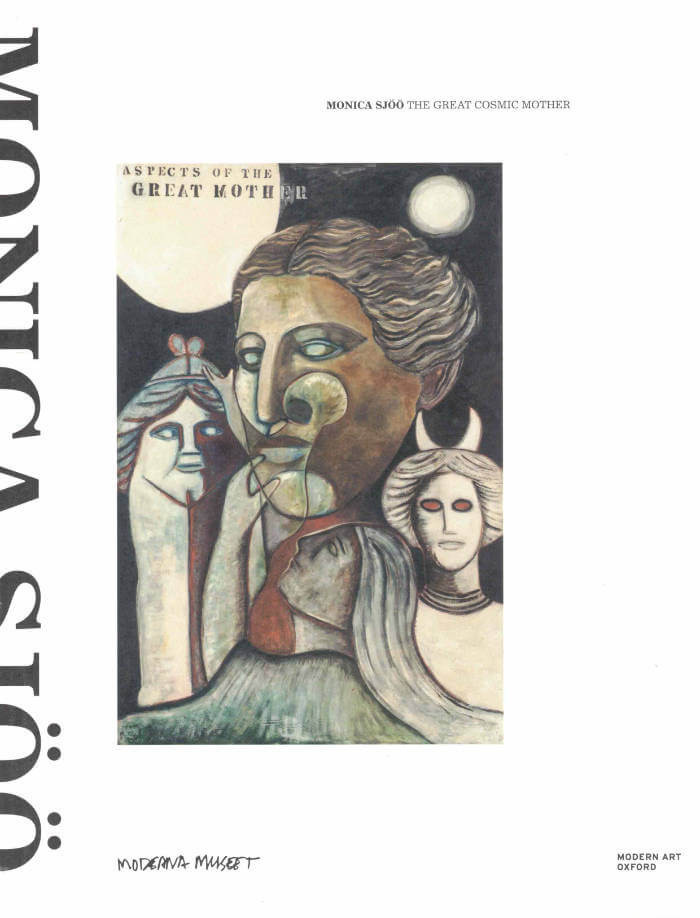
The Great Cosmic Mother
As a pioneer of feminist art and female spirituality, Sjöö began producing images that sought to express her growing resentment for social injustices.
Later works speaks to ancient knowledge and belief systems, drawing imagery from pagan sites and female symbols of the past, reflecting her lifelong research into ancient matriarchal cultures.
The catalogue traces the artist’s deep commitment to gender and environmental justice.
Contributions by Amy Budd, Jennie Klein, Olivia Plender, Jill Smith, Lucy Stein, Monica Sjöö, Amy Tobin, Jo Widoff, Annika Öhrner
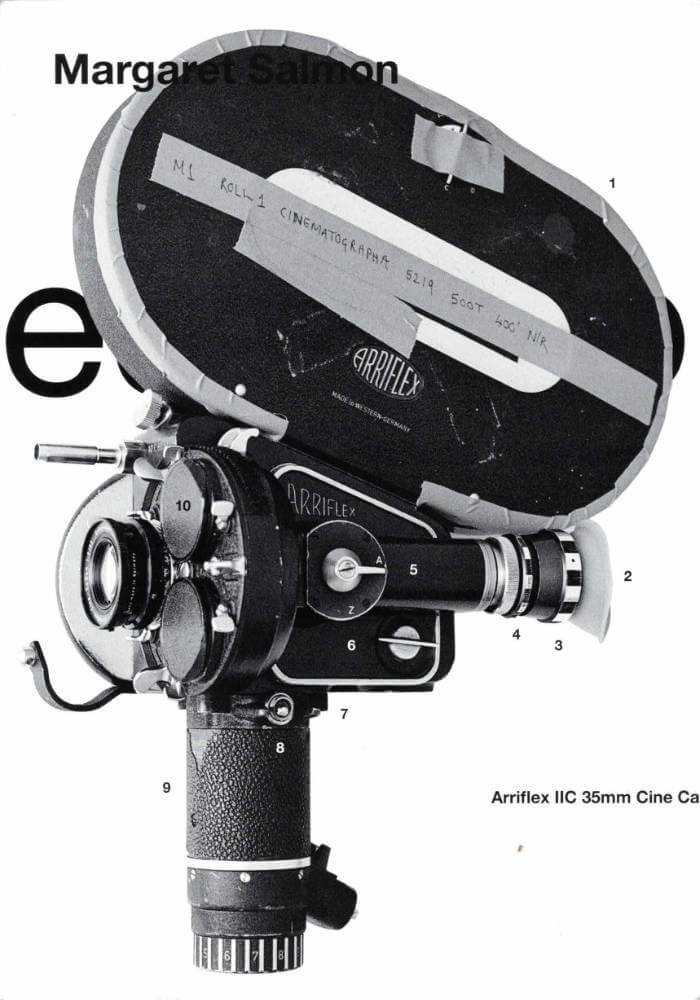
Cinematographa
Conceived by artist and filmmaker Margaret Salmon, this publication is a tribute to a group of innovative sister cinematographas and to the analogue motion picture camera. The book pairs an enquiry into women’s filmmaking practice with a comprehensive survey of experimental analogue technique across generations.
Nine filmmakers – Peggy Ahwesh, Betzy Bromberg, Rose Lowder, Babette Mangolte, Rhea Storr, Deborah Stratman, Alia Syed, Malena Szlam and Salmon herself, speak about the ways they use and think about their cameras, sharing technical knowledge and reflections on camera work to reveal their creative philosophies and intentions.
Included with the book is a separate manual: “An Artists' Guide to Analogue Cinematography”. This learning pamphlet was written and photographed by Salmon, and includes step by step instructions to the loading and basic use of three cine cameras.
Texts: Peggy Ahwesh, Betzy Bromberg, Rose Lowder, Babette Mangolte, Margaret Salmon, Rhea Storr, Deborah Stratman, Alia Syed, Malena Szlam
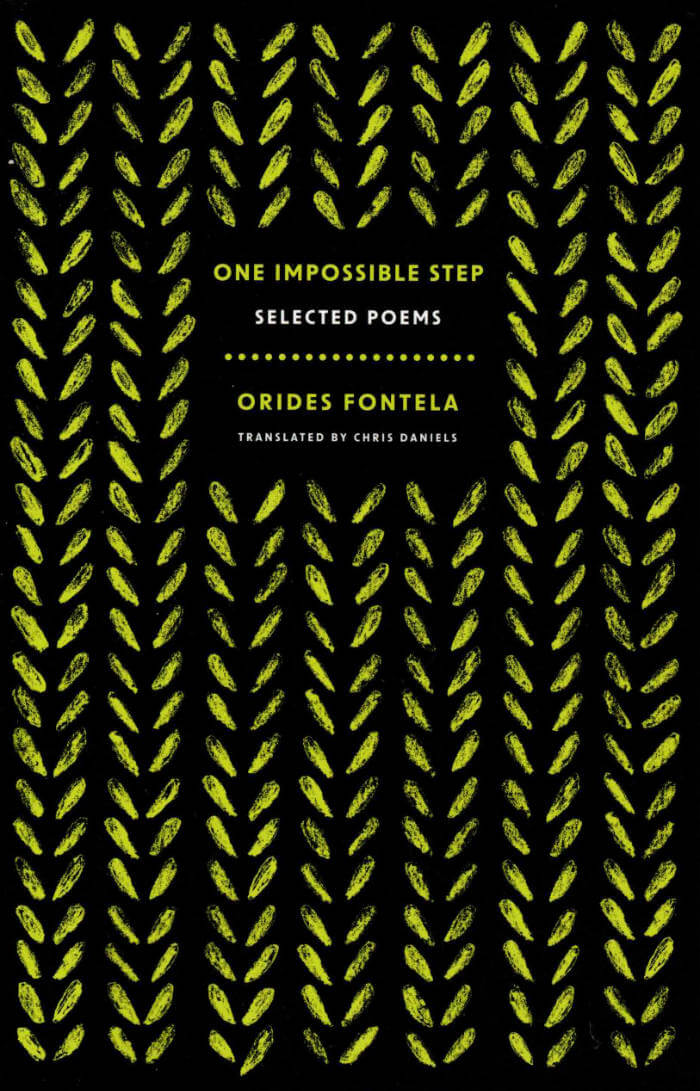
One Impossible Step
A selection of extraordinarily condensed, emotionally complex, philosophical poems by a unique and highly regarded 20th-century Brazilian poet.
In her lifetime, Orides Fontela resisted all labels, all attempts to situate her work in a particular movement, school, tendency, or tradition. Here, in her first ever English-language collection, Fontela’s poetry continues to defy easy categorization. In these concise, meditative poems, Fontela’s bird and flower, water and stone, blood and star can be read as symbols, indicating a possible tendency toward mysticism. Including an illuminating statement of poetics and excerpts from her often acerbic interviews, One Impossible Step introduces English-language audiences to an iconoclast who remains one across languages and decades.

desespiegles
This publication is presented as an object-book-manifesto of a ‘desespiegles’ way of thinking. It “translates” the trains of thought that architect-artists Anne Philippe and Jolien Naeyaert exchanged via videoletters. The videoletters mainly occurred during the covid period. Questioning the scope of the addressed images, these exchanges revealed a play of symmetries. It shows a series of interrogations, linking the intimate with the collective. The move towards a publication was obvious after conversations with Loes, Phyllis, An and Teresa of nadine. The desire to activate reading in a performative way, mirrors the exchange of videoletters. It continues the process-based methodology that inventively gave birth to a publication through the physical manipulation of the work. The riso-technique proved particularly suitable for this project, as the hands, the gaze and the exchange all played a role during the object-making process.
Dannie.n is an art-zine, published by nadine, about the artistic research, themes, and topics of discussion of the artists involved in nadine. nadine invites an artist or collective to create each new edition.
Dannie.p is a limited-edition artist's book by desespiegles (57 copies). nadine is supported by Vlaamse Gemeenschap, VGC, Brussels Hoofdstedelijk Gewest.
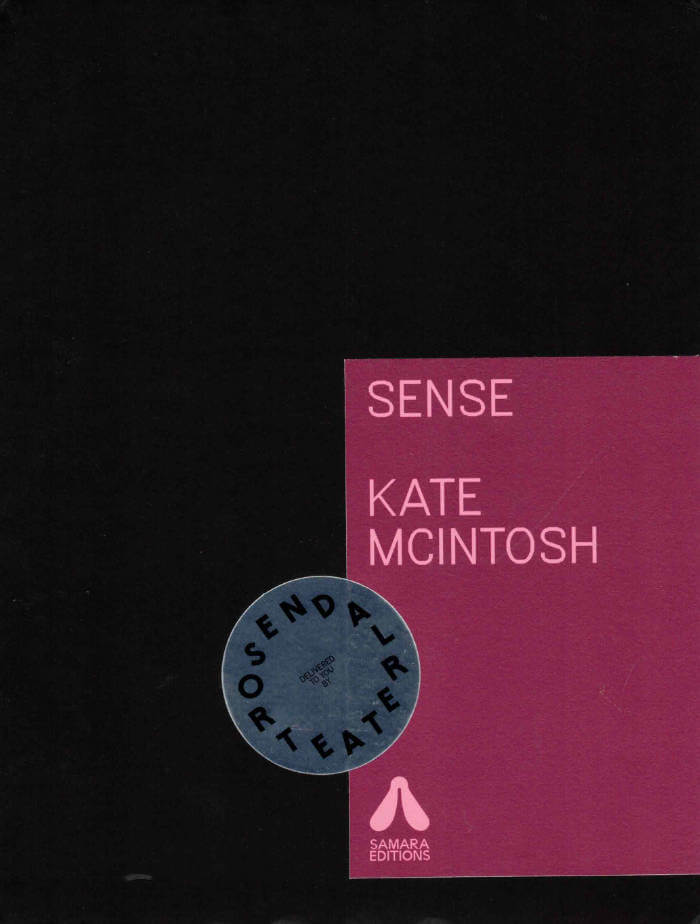
SENSE
Sense is a box of simple actions to try whenever you like. The Sense box contains three separate proposals - each one is unique and to be experienced independently from the others. The three parts are: a scent that confuses the wearer about their species, a ritual that turns the heart into a spray of lights, and a card game to start unexpected interactions among unknown hands. Sense is a subtle collection of sensory stimulants that are designed to open and rearrange perception of everyday events. Discover this box in your own time, and share with whoever you like. Take elements of it on your travels and try them with as many people as you can - the more friends and strangers do it, the more intriguing it can be.
Kate McIntosh creates work in a variety of different media, such as performance, theater, video and installation. Both humor and the link with science and experimentation are elements that frequently pop up in Kate’s work. Her practice is guided by her ongoing fascination with with misusing objects, and creating playful relations between spectators.

Protoplasmic Flow
One of artist Jenna Sutela's regular collaborators, Physarum polycephalum, is often referred to as a natural computer. This yellow, ‘many-headed’ slime mold is an ancient, decentralized, autonomous organism that processes data without a nervous system, operating via communities of coordinated nuclei that demonstrate advanced spatial intelligence. If the slime mold cannot find the resources it needs, it hibernates until better conditions arise; theoretically, it is immortal. Over the years, Sutela has, for example, ingested the slime mold in her performances as a form of artificial intelligence, letting its hive-like behavior program her own.
Sutela's work for Samara reactivates this line of work, delivering co-existence with the slime mold to people's homes in the form of a dried sample of Physarum polycephalum as well as related performative instructions. Inside the box, the audience receives everything necessary to grow slime mold at home, and witness the behaviour of this fascinating organism. With the set of performative instructions, Jenna Sutela proposes the ways of co-existing and engaging with Physarum polycephalum.
Jenna Sutela works with words, sounds, and other living media, such as Bacillus subtilis nattō bacteria and the “many-headed” slime mold Physarum polycephalum. Her audiovisual pieces, sculptures, and performances seek to identify and react to precarious social and material moments, often in relation to technology. Sutela's work has been presented at museums and art contexts internationally, including Guggenheim Bilbao, Moderna Museet, and Serpentine Galleries. She is a Visiting Artist at The MIT Center for Art, Science & Technology (CAST) in 2019-21.
Protoplasmic Flow contains everything required to activate the slime mold in a location of your choosing.
Duration: take all the time that you need
Language: Instructions are in English and Italian.

sur la route
sabiche, les lutins dîle de france and 1 more
Sur la route, de sabiche est la version housewife-poétesse kicked out de la maison où elle vivait, qui se retrouve on the road yeah, le long des pissenlits traînant d'énormes valises, pleines de livres et de bidules inutiles-essentiels, dont un crâne humain avec qui elle parle. Des lutins et Dodie Bellamy - dont sabiche traduit l'essai "L'écriture comme accumulation compulsive" - viennent l'aider...